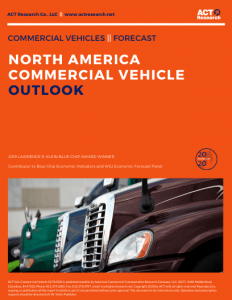ACT Research Analysts Say Freight Market Robust

Analysts Say Freight Market Robust
The list of things to like from the current economic, freight and commercial vehicle demand perspectives is long, according to ACT Research’s latest release of the North American Commercial Vehicle Outlook.
Kenny Vieth, ACT Research President and Senior Analyst
“From the freight perspective, spot rates continue to post new record levels and are currently inverted relative to contract rates, a clear signal that contract rates will continue to rise,’’ said Kenny Vieth, ACT president and senior analyst. “Additionally, low business inventories and backed-up ports on both coasts have created a backlog of freight, providing excellent forward visibility for continued strong demand for freight services.
“From a commercial vehicle demand perspective, orders, from medium-duty trucks to heavy-duty tractors and trailers, remain elevated, and backlogs for tractors and van-type trailers, at current build rates, are beyond 12 months, meaning that overall backlog-to-build ratios extend well beyond traditional ranges. Our song remains the same: the current business environment for heavy-duty trucks is about as good as any we have seen in 35 years of monitoring heavy-duty market conditions at ACT Research.”
ACT’s outlook is a robust report that forecasts the future of the industry, looking at the next one to five years, with the objective of giving manufacturers, Tier 1 and Tier 2 suppliers, and investment firms the information needed to plan accordingly for what is to come.
Enjoying our insights?
Subscribe to our newsletter to keep up with the latest industry trends and developments.
Stay InformedThe report provides an overview of the North American markets. That includes looking at relevant, current market activity to highlight orders, production and backlogs, shedding light on the forecast.
Information included in the report covers forecasts and current market conditions for medium and heavy-duty trucks, tractors and trailers, the macro-economies of the US, Canada and Mexico, publicly-traded carrier information, oil and fuel price impacts, freight and intermodal considerations, and regulatory environment impacts.





















